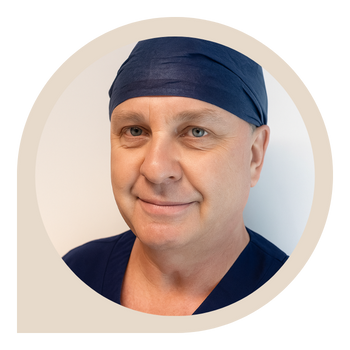Dr. Mark Irving
Exposures and Bonding
Sometimes, a tooth, particularly a canine, can become “stuck” beneath the gumline and may need a little assistance to emerge properly. In such cases, I recommend a minor procedure called exposure and bonding. This procedure allows us to safely guide the tooth into its correct position as part of your orthodontic care.
Why is it done?
After careful evaluation, I may recommend exposures and bonding when a tooth—most often an upper canine—doesn’t erupt naturally and remains trapped beneath the gum or bone. This situation is commonly caused by crowding, the angle of the tooth, or limited space in your dental arch. If left untreated, an impacted tooth can lead to issues such as crowding, misalignment of nearby teeth, damage to adjacent roots, or the development of cysts or infections over time.
With exposures and bonding, I carefully uncover the impacted tooth and attach a small bracket and chain. This allows your orthodontist to gently guide the tooth into its proper position as part of your orthodontic treatment. Early intervention is important—not only does it help prevent more complicated dental problems later on, but it also supports a healthier bite and a more balanced, attractive smile.
Ultimately, exposures and bonding are about giving every tooth the best chance to emerge in its proper place, protecting your oral health and ensuring the best possible long-term outcome.
Exposures and Bonding: What You Need to Know
What is “Exposures and Bonding”?
Exposures and bonding are minor surgical procedures performed by specialists such as Dr Mark Irving, an Oral Pathologist and Maxillofacial Surgeon, when a tooth—most commonly an upper canine—becomes impacted and fails to erupt naturally through the gum tissue or bone. This impaction can cause discomfort, increase the risk of infection, or lead to misalignment of neighbouring teeth. During the procedure, Dr Irving carefully exposes the crown of the impacted tooth by making a small incision in the gum tissue, providing direct access to the tooth. Once exposed, a small bracket or chain is bonded to the tooth, allowing the orthodontist to gradually guide it into the correct position over time. This intervention not only helps the natural eruption of the tooth but also supports improved dental alignment and oral health. Comprehensive postoperative care, overseen by Dr Irving, is crucial to promote healing and monitor for any potential complications.
Gentle Exposure
During the exposures and bonding procedure, Dr Irving meticulously unveils the impacted tooth by delicately removing a small section of gum tissue—or, if necessary, a thin layer of bone—to access the tooth’s surface. Using specialised surgical instruments and techniques, he ensures minimal trauma to surrounding tissues and provides a clear field for precise manipulation of the impacted area. Patient comfort is always a priority, and Dr Irving administers local anaesthesia to ensure the procedure is as painless as possible. Once the tooth is accessible, Dr Irving assesses its position and determines the most effective approach for ongoing treatment, whether extraction or orthodontic guidance.
Promotes Healthy Alignment
Exposures and bonding techniques are fundamental components of orthodontic and surgical care provided by Dr Irving. These procedures facilitate the correct positioning of impacted teeth and help prevent a range of complications that may arise if impaction is left untreated, including infection, misalignment of adjacent teeth, and challenges in maintaining oral hygiene. Early intervention by Dr Irving can help patients avoid more invasive treatments in the future. By supporting both the functional and aesthetic aspects of dental health, exposure and bonding contribute to a healthier, more balanced smile and improved self-confidence. Additionally, proper alignment promotes better chewing efficiency and reduces the risk of future dental issues.
Guided Tooth Movement
Once the bracket and chain are in place, the orthodontist works collaboratively with Dr Irving’s surgical foundation, using the attached chain to carefully and gradually move the impacted tooth into its ideal position within the dental arch. This staged movement is an integral part of the patient’s comprehensive orthodontic treatment plan, designed to correct misalignments and establish a healthy bite. Over a series of appointments, the orthodontist will monitor the progress and make necessary adjustments to the chain, ensuring controlled, safe, and effective repositioning of the tooth. This detailed approach, enabled by Dr Irving’s surgical expertise, not only enhances the patient’s smile but also supports long-term oral health and function.
Post-Op Care
Please use the following information as a general guideline. If you have any concerns after surgery, please get in touch with Dr. Irving's office at (02) 9890 1822.
Important
You should reach out to your surgeon, general practitioner, or the nearest accident and emergency department if you experience any of the following issues:
Severe pain that is not relieved by the recommended medication
Ongoing bleeding
Any other significant problems following the operation



